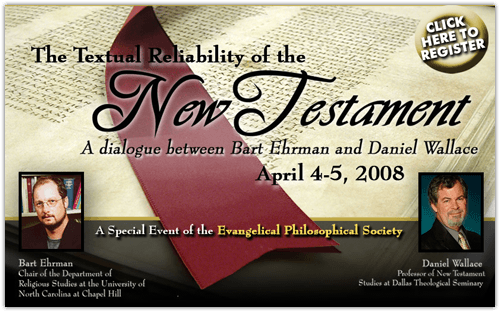The Epistle of Jude: Its Text and Transmission, http://www.bookreviews.org/bookdetail.asp?TitleId=5824. Reviewed by Stephen D. Patton
The review is appreciative of Wasserman's work. Ironically, Patton's Greek accents are incorrect in three places.
A forum for people with knowledge of the Bible in its original languages to discuss its manuscripts and textual history from the perspective of historic evangelical theology.
“Two of the hottest issues in evangelical theology right now are the New Testament’s use of the Old Testament and evangelical textual criticism.” (Ted Olsen, ‘Westminster Theological Seminary Suspends Peter Enns’)
.jpg)
.jpg)



On April 4-5, 2008, Dr. Dan Wallace, professor of New Testament Studies at Dallas, will participate in a debate with Dr. Bart Ehrman, chair of the department of religious studies at University of North Carolina Chapel Hill, over the textual reliability of the New Testament.For more information, please visit http://www.greer-heard.com/.
I have always viewed ευθυς as a nice marker of Matthew's use of Mark. But then again, I have always been, and am currently, a textual Alexandrian, though with room for doubt. [Was there really a 4th century Byzantine redaction that purged most Alexandrian influence?]
In the Westcott-Hort text and the Moulton-Geden concordance:
Matthew uses ευθεως 10 [11] times 4.20, 22, 8.3, 13.5, [14.22], 31, 20.34, 24.29, 25.15, 26.49, 27.48.
Matthew also uses ευθυς 7 times 3.16, 13.20, 21, 14.27, 21.2, 3, 26.74.
Mark never uses ευθεως.
Mark uses ευθυς 40 [41] times 1.10, 12, 18, 20, 21, 23, 28, 29, 30, 42, 43, 2.8, 12, 3.6, 4.5, 15, 16, 17, 29, [5.2], 29, 30, 42, 42, 6.25, 27, 45, 50, 54, 7.25, 8.10, 9.15, 20, 24, 10.52, 11.2, 3, 14.43, 45, 72, 15.1.
Since ευθυς is a Marcanism, the probable conclusion is that Matthew has borrowed seven examples of ευθυς from Mark, but himself prefers ευθεως. This becomes a clear trace-element. Just what forensics want on a CSI investigation.
Let's look at the Byzantine text.
The Byzantine text has ευθεως 40 times and ευθυς 2 [Mk 1.12, and 1.28].
Neither of the examples of ευθυς in Byz Mark have an ευθυς in Matthew! Byz Mark 1.12 is parallel to a Matthean narrative-τοτε, a distinctive Mattheanism that is not picked up in Mark anywhere. Byz Mark 1.28 is 'Marcan material' that has no equivalent in Matthew [Byz or Alex].
What is remarkable, is that regarding ευθυς/ευθεως in the Byzantine text the literary flow Mark to Matthew does not exist. Yet the Alexandrian text has a clear literary flow from Mark to Matthew on this point. Alexandrians can point to ευθυς as evidence that Matthew used Mark. But that datum is only as strong as the textual theory.
This is offered to Peter Head, who will be speaking on this subject more broadly at an upcoming synoptic studies conference. For fuller discussion and data see my blog http://alefandomega.blogspot.com/2008/04/textual-criticism-and-synoptics-case-of.html